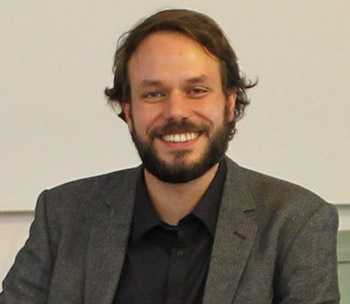
Jiří Kocian
Jiří Kocian started out using the Visual History Archive himself as a researcher. Now, he’s helping others discover testimony as the coordinator of the Malach Center for Visual History at Charles University in Prague.
Kocian is finishing his PhD at Charles University and received his MA there in Area Studies. Though he has graduated, he remains involved in research and teaching at the university’s Institute of International Studies and has continued developing his own research of modern history and contemporary development in Southeast Europe, specifically the history of Jewish communities in the region.
Because of his research interests and involvement in the university, Kocian was invited to attend a seminar led by former Malach Centre coordinator Jakub Mlynář about working with the Visual History Archive and testimony. The Malach Centre is the only site with full access to the Visual History Archive in Czech Republic.
“From the very first moment, I was immediately overwhelmed in a good way by the volume of the sources, by the way in which the interface aids in their finding and analyzing and also realized how broad is the palette of their research, educational and other use,” Kocian said.
Following the seminar, Kocian joined a project team lead by two prominent researchers in the field of Jewish history from the Czech Republic and Slovakia, Kateřina Králová and Hana Kubátová, which aimed at completing the most comprehensive research yet carried out in the Malach Centre using testimonies from the Visual History Archive. The final result has just been published as a book entitled Coming Back: The Post-war Reconstruction of Jewish Communities in the Central-Eastern, South-Eastern and Eastern Europe (in Czech Návraty: poválečená rekonstrukce židovských komunit ve středovýchodní, jihovýchodní a východní Evropě).
Kocian believes testimony represents a completely different, personal perspective on history, in many cases enhancing or relativizing accepted narratives of genocide. However, testimony as a source (especially the visual one) offers much more than just an additional point of view on well-known historical events.
“It offers a very plastic, multi-layered narrative of individuals, their perception of self, others and relationships among these during the times of past tragedies, but also their coming to terms with these terrible experiences and their further life,” Kocian said. “The testimonies recorded specific languages, discourses and emotions in regard to the memories of those interviewed, as represented during the moment of the interview.”
After meeting Mlynar, Kocian succeeded him as the coordinator of the Malach Center. His job involves helping visitors learn to use and search the Visual History Archive, offer his expertise to researchers, and host public seminars about the Visual History Archive.
Kocian tailors his services to match the needs of each visitor. For researchers, he gives them a succinct introduction to the VHA interface and offers suggestions for how to find the specific testimonies they’re looking for. Community visitors often need help finding a relative in the archive. Students usually require a more comprehensive overview of oral history theory and practice followed by discussion of the testimony content.
“Everyone new to the archive is always astonished by its size and variability, as I was the first time and I still am,” he said.
The nature of testimony makes it a very special and valuable source, Kocian said. Besides that, the VHA always leaves a very deep personal impact on anyone who gets a chance to use it and watch the interviews.
“In this respect, it definitely fulfills its general aim to send a message from one generation to another about the suffering of the victims of the Holocaust and other genocides in order to facilitate better understanding, education and fighting prejudice, hatred and following acts of violence,” he said. “The very personal form in which such information is shared through VHA can definitely make a difference. And we are happy to be part of and help this important process here at the Malach Center.”